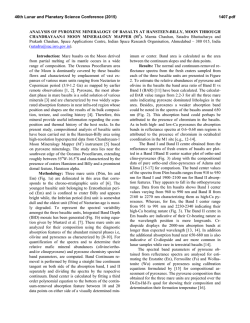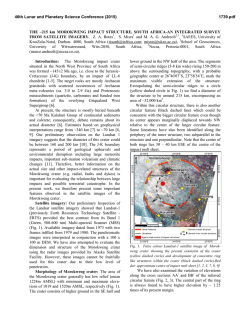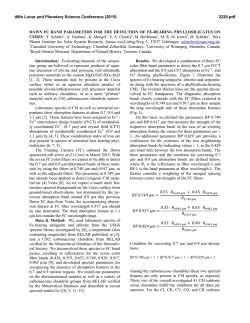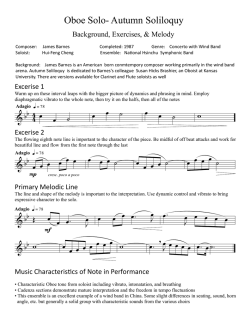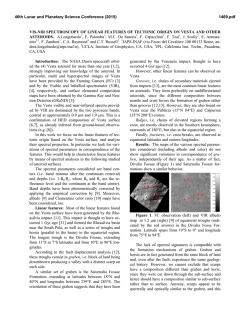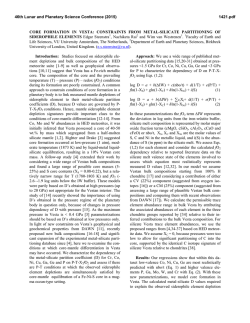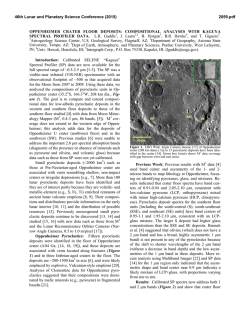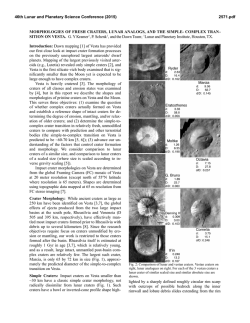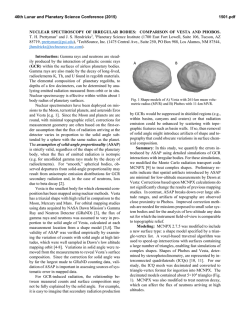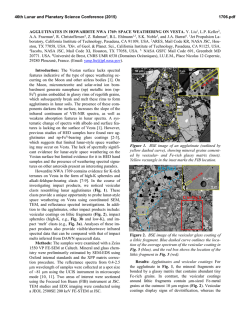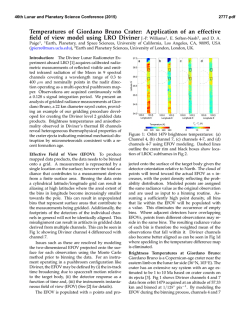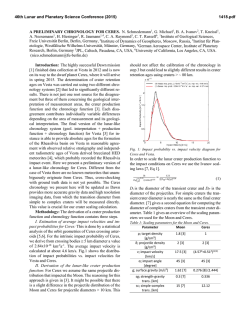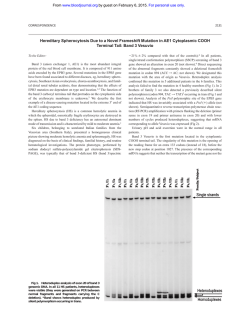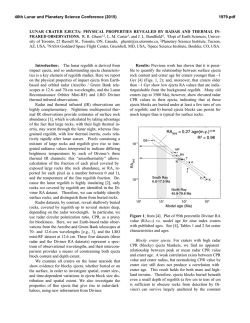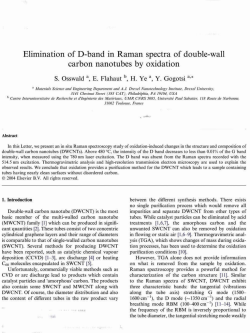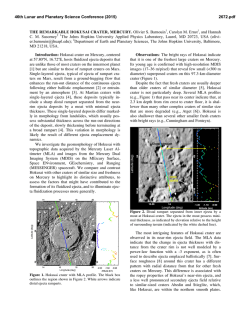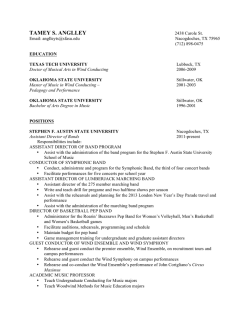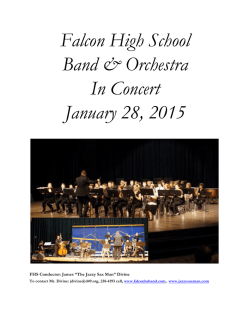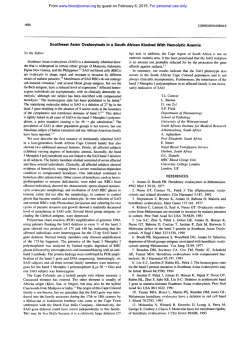
DAWN AT VESTA: COMPOSITION OF THE NORTHERN REGIONS
46th Lunar and Planetary Science Conference (2015) 2098.pdf DAWN AT VESTA: COMPOSITION OF THE NORTHERN REGIONS. J.-Ph. Combe1, T. B. McCord1, L. A. McFadden3, S. Ieva2, F. Tosi4, A. Longobardo4 , M. C. de Sanctis4, E. Ammannito4,5, A. Frigeri4, C. A. Raymond5, C. T. Russell6, 1Bear Fight Institute, 22 Fiddler’s Road, P.O. Box 667, Winthrop, WA 98862, USA (jeanphilippe_combe @ bearfightinstitute.com / Fax: +001-509-996-3772). 2Goddard Space Flight Center, Greenbelt, MD, USA. 3Observatoire de Paris, Meudon France / Osservatorio Astronomico di Roma, Roma, Italy. 4IAPS-INAF, Rome, Italy. 5 University of California Los Angeles, CA, USA. 6Jet Propulsion Laboratory, Pasadena, CA, USA. Introduction: Asteroid 4 Vesta’s mafic rich lithology reflects differentiation in the interior and is similar to the HED meteorites, from the upper crust (eucrites) to the lower crust (diogenites). We investigated the ancient crust by analyzing how meteorite impacts processed and transformed the composition of the northern regions, masking, mixing, excavating and exposing the lithology that resulted from differentiation prior to the bombardment phase of the Main Asteroid Belt’s evolution. We focused on the northern regions, latitudes higher than 22°N, by interpreting the composition, mostly from the Dawn Visible and Infrared Mapping Spectrometer (VIR, [1]), but also from the Gamma-Ray and Neutron Detector (GRaND, [2]) and the Framing Camera (FC, [3]). We tested four possible effects of impact-related processes: 1) Did Rheasilvia ejecta reach the northern regions, as suggested by ejecta distribution modeling [4]? Our approach is to identify correlations between models of ejecta distribution and maps of the composition. 2) Was the surface chemistry and composition at Rheasilvia and Veneneia antipodes disturbed by the impacts, as it appears to be on the Moon [5,6]? 3) We tested whether Mamilia crater’s northern wall (Fig. 1) compositions are representative of the subsurface of the northern regions. Mamilia crater is a 35-km impact crater centered at 48°N and 293°E, relatively young compared to the rest of the surface of the northern regions. High contrast in albedo and composition on the northern wall suggests excavation of pure components. 4) Is the origin of the component found in Bellicia crater, suggested to be olivine, related to Rheasilvia? What are other possible scenarios? Fig. 1:Mamilia crater as observed by Dawn’s Framing Camera Methods: In order to provide a common basis for the compositional analysis of Vesta’s quadrangles, maps of several spectral parameters were produced, including pyroxene absorption band depth and position [9], the 2.8-µm absorption band depth and the 1.4-µm reflectance [10]. In addition, modeling of the distribution of Mamilia’s northern wall materials required performing spectral unmixing [11] using the entire spectrum. Results: Our analysis of the surface composition of the northern regions of Vesta confirm, reinforce or support the following hypotheses: 1) diogenite-rich ejecta from Rheasilvia did reach the northern regions (Fig. 1) as predicted [4], 2) Rheasilvia and Veneneia impacts did not disturb the surface composition at their antipodes (Fig. 1, 2), as shown by previous analyses [5,6], 3) Mamilia crater’s northern wall compositions are representative of the subsurface of the northern regions, which contain eucritic, diogenitic and dark hydrated materials within a few kilometers, and 4) an area defined by Bellicia, Arruntia and Pomponia craters hosts a different composition than the rest of Vesta, interpreted previously to be rich in olivine [7,8], but possibly containing mixtures of pigeonite, hypersthene and diopside with no olivine, all of which may have an exogenous origin. References: [1] De Sanctis et al., (2011) SSRv, 163, 329-370. [2] Prettyman et al. (2011) SSRv. 163, 371-459. [3] Sierks et al. (2011) SSRv 163, 263-327. [4] Jutzi et al. (2013), Nature 494, 207-210. [5] Lü, et al. (2011), PSS 59, 1981-1991. [6] Wieczorek and Zuber, (2001), JGR 106, 27853-27864. [7] Ammannito et al. (2013), Nature 504, 122-125. [8] Ruesch et al. (2014), JGR 119, 2078-2108. [9] Frigeri et al. (2015), submitted to Icarus. [10] Combe et al. (2015), submitted to Icarus. [11] Combe et al. (2008), PSS 56, 951–975. [12] Browling et al. (2013), JGR 118, 18211834. [13] Park et al. (2014), Icarus 240, 118-132. Acknowledgements: The funding for this research was provided under the NASA Dawn mission through a subcontract 2090-S-MB516 from the University of California, Los Angeles. VIR instrument and VIR team is founded by ASI (Italian Space Agency) and INAF (Istituto Nazionale di Astrofisica) 46th Lunar and Planetary Science Conference (2015) Fig.2: Vesta surface composition from VIR data, displayed as a Red-Green-Blue color composite. Red: Pyroxene absorption band depth ratio Band I / Band II. Green: Pyroxene absorption band I position. Blue: Pyroxene absorption band II position 2098.pdf Fig.3: Vesta surface composition from VIR data, displayed as a Red-Green-Blue color composite. Red: 1.4-µm reflectance in the range 0.2-0.4. Green: Sum of pyroxene absorption band I depth and pyroxene absorption band II
© Copyright 2026

